# Projects
Workato projects serve as repositories for your integration assets, including recipes, connections, and sub-folders. The projects page is divided into two sections:
Assets
Contains Smart folders, which dynamically display all recipes, connections, and pages across your projects, providing a centralized location for managing your integration assets.
Projects
Displays a list of all available projects.
SUMMARY
- Workato projects act as repositories for integration assets such as recipes, connections, and sub-folders.
- Organize projects by use case, department, app, or process.
- You can share connections across projects.
- Admins manage user permissions to create, edit, view, or delete projects.
Watch a 2 minute video guide about Projects
SHARING CONNECTIONS
Connections can be shared across multiple projects.
# Best practices for using projects
Managing and organizing your projects streamlines collaboration and improves navigation across teams. Follow these best practices to stay organized and optimize your workspace's productivity:
# Organize projects
Organize your projects by department, use case, or project type to create a clear, logical structure. This enables you to efficiently locate and manage related assets.
 Example of organizing by use case
Example of organizing by use case
# Recipe lifecycle management
Ensure the target workspace has a project available to import the exported project when managing recipe lifecycles across workspaces. You can create a project with the same name as the exported project to maintain consistency if the project doesn't exist.
After creating the project, import the exported project. If you import into All projects, each folder is converted into a separate project.
# Home assets project
Workato no longer allows you to create assets without assigning a project to align with the updated permissions model.
Workato plans to convert the Home assets folder to a project with full capabilities. Workato maintains the folder_id and project_id during migration. To determine if your Home assets folder has been converted to a project, use the following guidelines:
- If there is a banner indicating that the project is deprecated, Workato has not yet converted your Home assets folder to a project.
- If there is no banner indicating that the project is deprecated, Workato has already converted your Home assets folder to a project with the same capabilities as any other project.
 Home assets legacy banner
Home assets legacy banner
MIGRATE ASSETS
You can migrate assets from the Home assets folder using the Workato UI, the Developer API, or the Embedded API. Refer to the Move assets section for additional information.
# Home assets project name
The Home assets project name varies as follows:
- The project is named Home assets if there isn't an existing Home assets project in your workspace.
- If your workspace contains a project named Home assets, Workato creates a new project named Home assets (migrated) for assets from the root folder. This preserves project-level access for collaborators without changes.
# API changes
You can't store assets in the Home assets folder after it has been converted. When importing or creating assets, you must specify a different folder in which to store them. As a result, changes have been made to the Workato APIs.
# Smart folders
Smart folders allow you to view all accessible recipes and connections. You can filter the list to show active or inactive recipes, and connected or disconnected connections.
 Smart folders
Smart folders
# Manage projects and permissions
Project roles control a collaborator's permissions to create, edit, view, or delete content within specific projects. You can assign collaborators a project role, such as Project admin, Builder, or a custom project role, to define their level of access.
PROJECT ACCESS
You can't share an individual project directly outside your workspace. To grant project access, invite collaborators to the workspace and assign them project roles for each specific project where they need access.
Project access permissions enable you to perform the following actions:
- Create a project
- Move folders, recipes, and connections between projects
- Delete a project
# Create a project
You can create a project to organize integration assets by department or use case. Recipes and connections can be stored directly in a project or organized within folders.
Complete the following steps to create a project:
Sign in to your Workato account.
Go to Projects in the navigation bar to access your project list.
 Create project
Create project
Select Create project.
Enter a Project name.
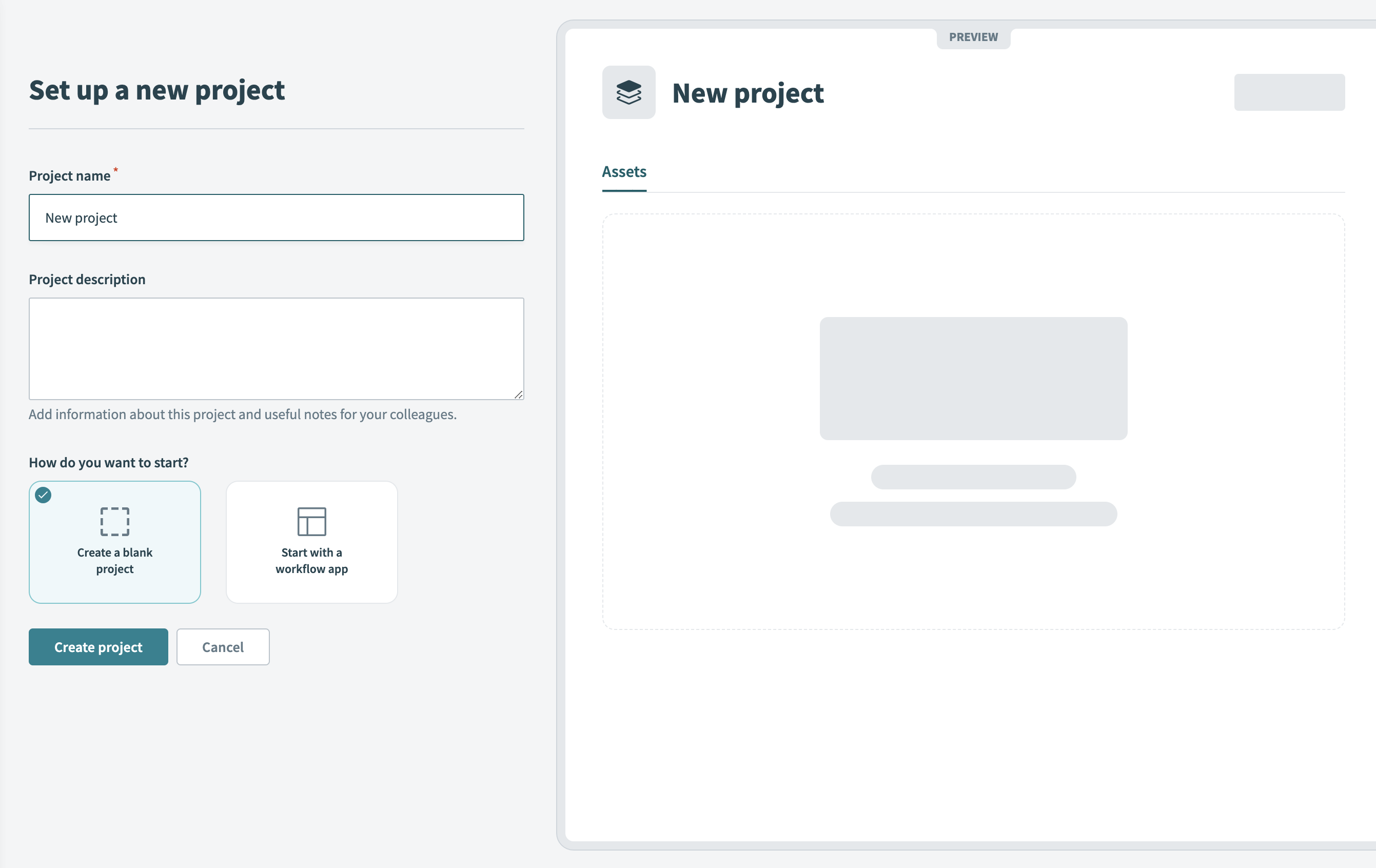 Enter a project name
Enter a project name
Optional. Create a Project description.
Select a starting point for your project:
- Create a blank project to build from scratch.
- Start with a workflow app.
Click Create project. The new project appears in the Projects menu.
# Create a folder
Complete the following steps to create a new folder in the new project:
Open the project view of the specific project and click Create folder.
 Create folder
Create folder
Enter a Folder name. The folder name must be unique at the same hierarchy level within its parent folder.
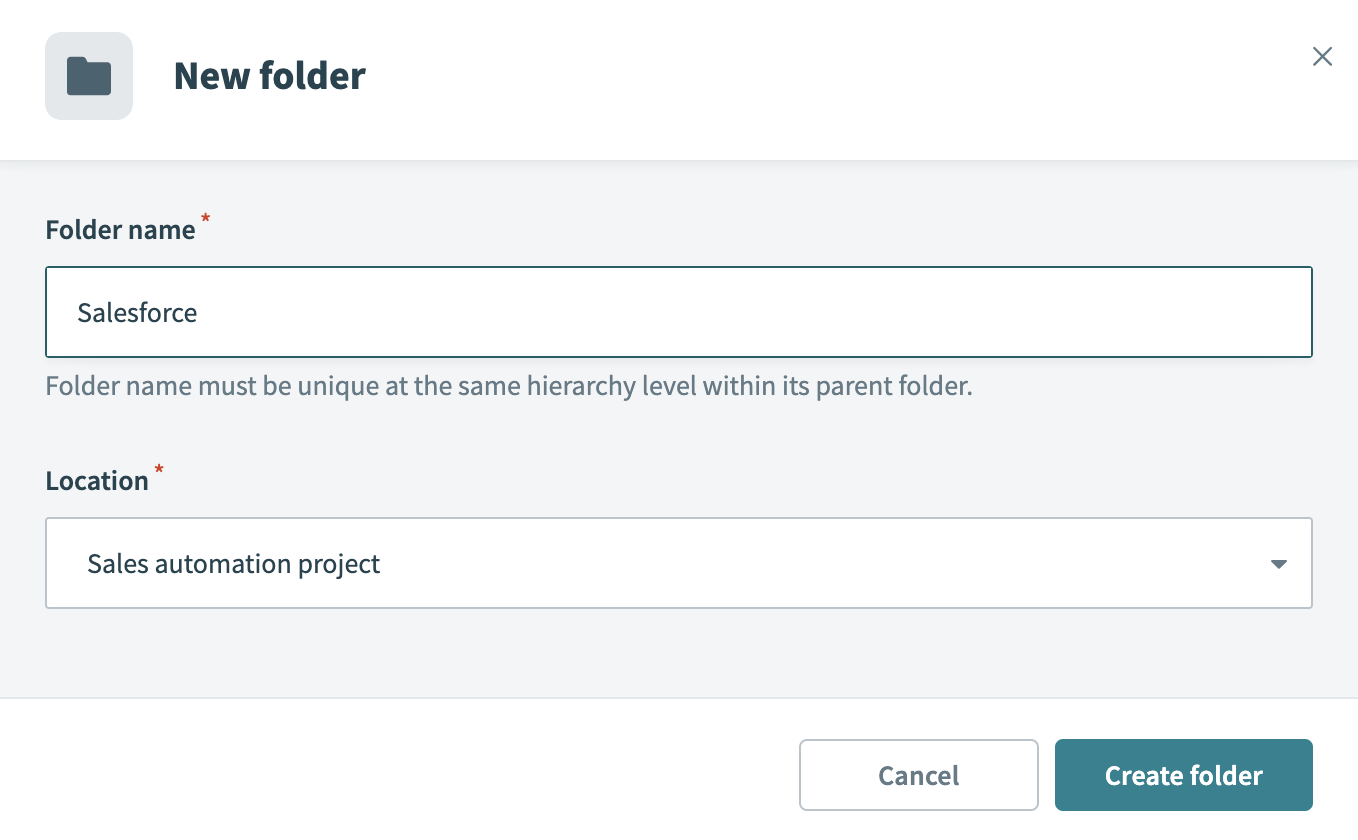 Enter a folder name
Enter a folder name
Use the Location drop-down menu to select the project where you plan to create the folder.
Click Create folder. The new folder appears as a sub-folder within the project.
# Assets tab
The Assets tab allows you to filter and manage assets specific to the selected project. It provides the same filters and sub-filters as the Assets page, but only applies to assets within the current project.
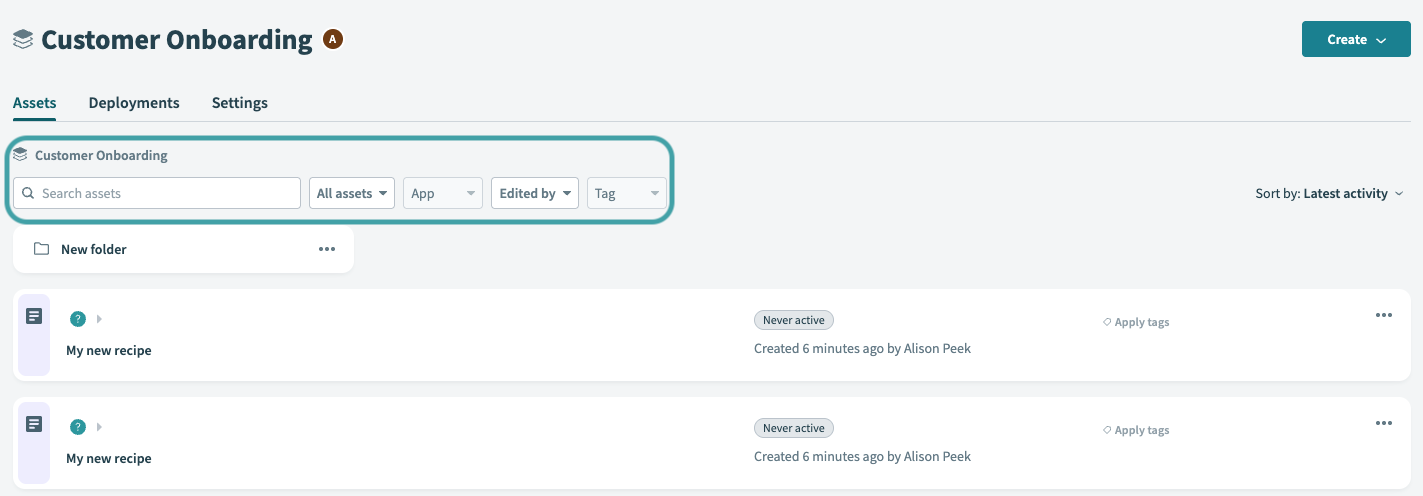 Assets tab filters
Assets tab filters
# Assets page
The Assets page provides the following filters:
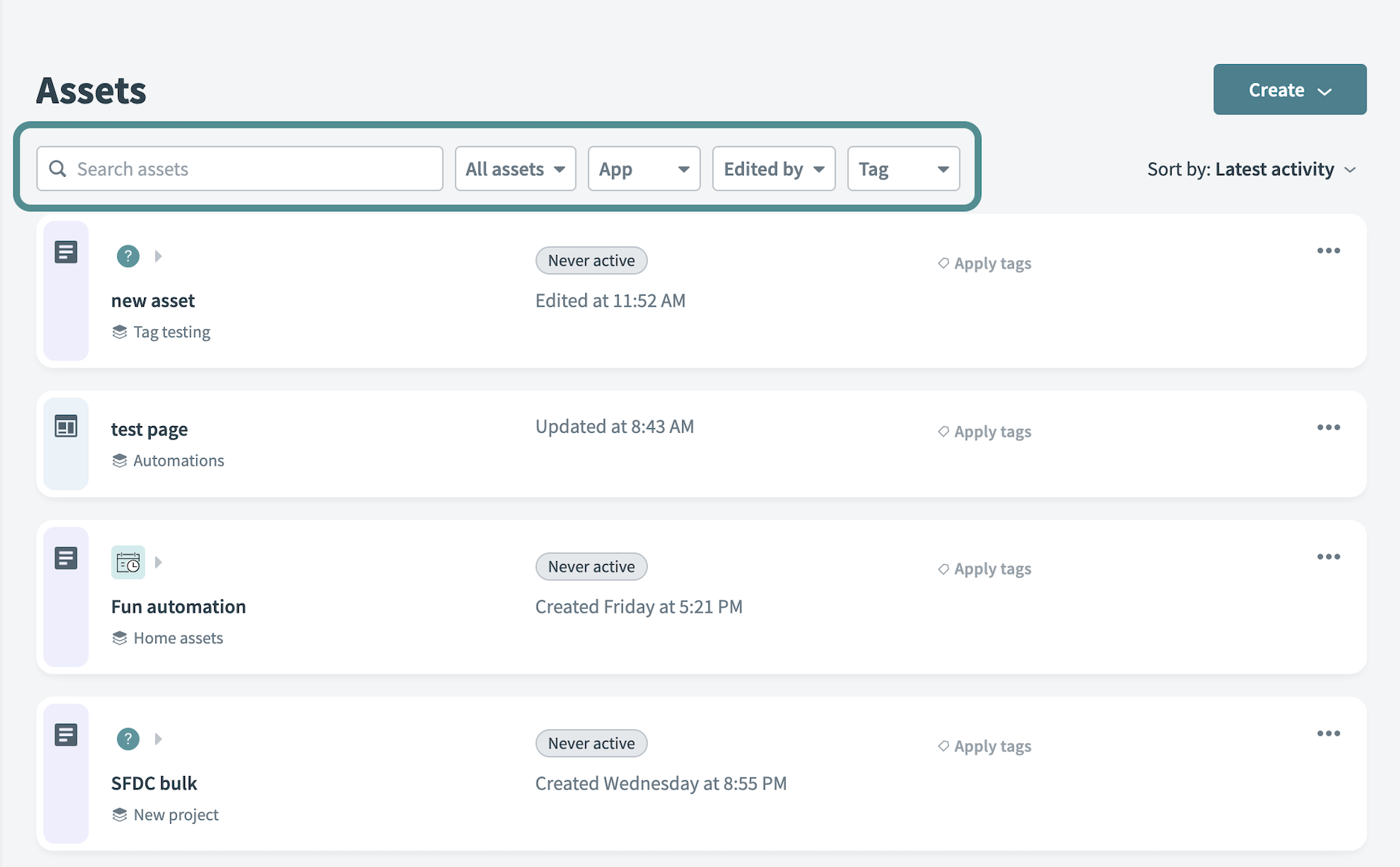 Assets page filters
Assets page filters
All assets
Filter by all types of assets, including recipes, connections, pages, genies, skills, and knowledge bases.
App
Select one or more apps. Only assets with the apps you select display in the results.
Edited by
Filter by the user who edited the assets. Choose Me to view assets you edited, or Others to select and view assets edited by specific collaborators within the workspace. Not all users can view assets edited by other collaborators.
Tag
Filter by tags to categorize assets such as recipes, connections, data tables, and pages.
These filter options provide additional sub-filters for granular search results.
# Sub-filters for assets
The Assets page and Assets tab both provide sub-filters for managing recipes, connections, and pages.
 Filter by assets
Filter by assets
# Recipes
The Recipes filter provides the following sub-filters:
| Sub-filter | Description |
|---|---|
| Status | Filter by Active or Inactive status. All statuses are shown if no option is selected by default. |
| App | Select multiple apps to filter recipes associated with those apps. |
| Recipe trigger | Choose one trigger option from an app, as each recipe can only have a single trigger. |
| Edited by | Filter by the user who edited the recipes. Choose Me to view recipes you edited, or Others to select and view recipes edited by specific collaborators within the workspace. Not all users can view recipes edited by other collaborators. |
| Tag | Filter recipes by tags to categorize them according to specific criteria. |
# Connections
The Connections filter provides the following sub-filters:
| Sub-filter | Description |
|---|---|
| Status | Filter by Connected or Disconnected status. All statuses are shown if no option is selected by default. |
| App | Choose one app to filter connections associated with that app. |
| Edited by | Filter by the user who edited the connections. Choose Me to view connections you edited, or Others to select and view connections edited by specific collaborators within the workspace. Not all users can view connections edited by other collaborators. |
| Tag | Filter connections by tags to categorize them according to specific criteria. |
# Pages
The Pages filter provides the following sub-filters:
| Sub-filter | Description |
|---|---|
| Edited by | Filter by the user who edited the pages. Choose Me to view pages you edited, or Others to select and view pages edited by specific collaborators within the workspace. Not all users can view pages edited by other collaborators. |
| Tag | Filter pages by tags to categorize them according to specific criteria. |
# Genies
The Genies filter provides the following sub-filters:
| Sub-filter | Description |
|---|---|
| Edited by | Filter by the user who edited the genie. |
| Tag | Filter genies by tags. |
# Skills
The Skills filter provides the following sub-filters:
| Sub-filter | Description |
|---|---|
| Edited by | Filter by the user who edited the skill. |
| Tag | Filter skills by tags. |
# Knowledge bases
The Knowledge bases filter provides the following sub-filters:
| Sub-filter | Description |
|---|---|
| Edited by | Filter by the user who edited the knowledge base. |
| Tag | Filter knowledge bases by tags. |
# MCP servers
The MCP servers filter provides the following sub-filters:
| Sub-filter | Description |
|---|---|
| Edited by | Filter by the user who edited the MCP server. |
| Tag | Filter MCP servers by tags. |
# Enhanced search functionality
The search functionality on the assets page offers faster, more accurate, and comprehensive search results.
 Search assets
Search assets
# Key search criteria
You can quickly find assets based on various criteria. The search targets the following fields within recipes, connections, and pages:
Asset names
Locate assets by their names.
Descriptions
Search within the descriptions of recipes.
Apps used
Filter assets based on the applications they use in recipes and connections.
Actions used
Identify recipes by the actions they perform.
SORT SEARCH RESULTS
Search results are sorted by relevance by default. You can change the sorting order, which remains in effect until you reset the search.
# Move assets
You can move assets using the Workato UI, the Developer API, or the Embedded API. Dependencies are automatically updated when you move an asset.
# Tags for assets
Tags allow you to categorize assets such as recipes, connections, data tables, and pages for better organization across projects. You can use tags to filter and search assets based on specific attributes.
 Tags for assets
Tags for assets
Refer to the Tags for assets documentation for more information.
# Delete a project
PROJECTS WITH ACTIVE ASSETS CAN'T BE DELETED
You can't delete a project with active assets.
When you delete a project, the project is permanently removed. Connections are deleted, and recipes are moved to the trash. From the trash, you can restore recipes to a new project or location, or delete them permanently.
 Restore deleted recipe
Restore deleted recipe
If you delete a connection used in other projects, it's removed from every project where it is used. This may cause recipes or workflows that rely on the connection to stop functioning due to the missing dependency.
Choose one of the following actions to delete a project from the Projects page:
- Drag the project to the Trash folder in the Projects menu.
 Delete by dragging the project
Delete by dragging the project
- Click the ... (ellipsis) next to the project, then click Delete.
 Click Delete
Click Delete
Last updated: 12/1/2025, 5:22:57 PM
 Drag and drop an asset
Drag and drop an asset Click the ... (ellipsis), then click Move
Click the ... (ellipsis), then click Move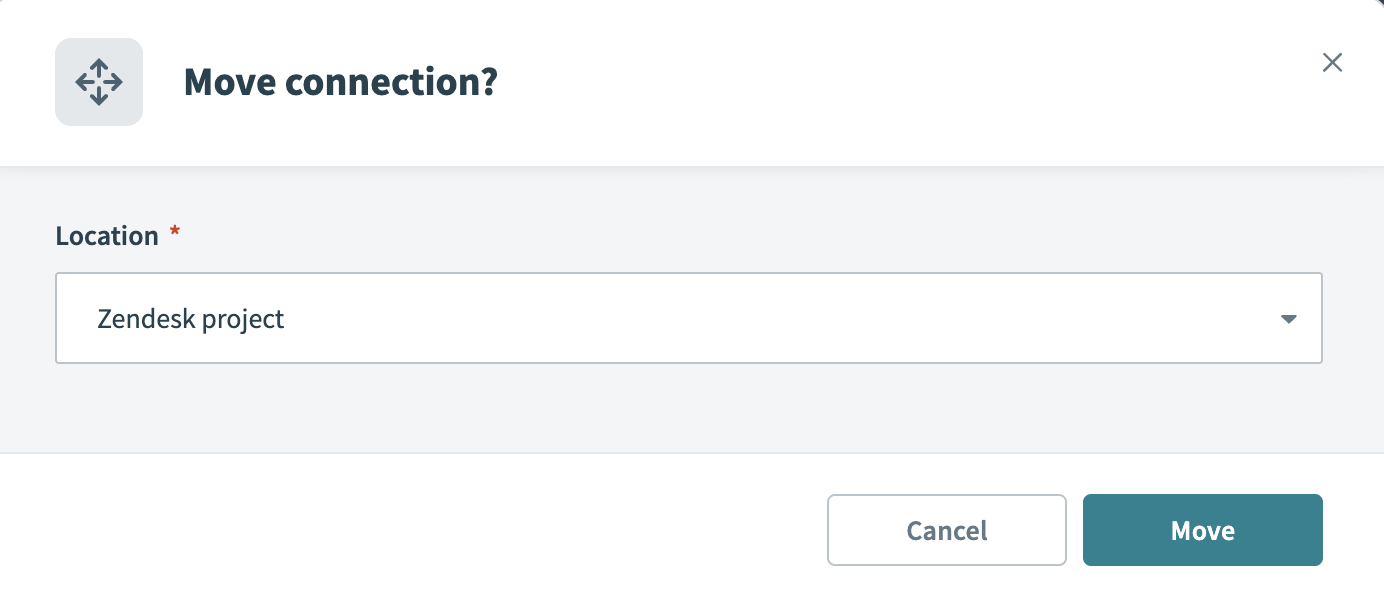 Select a new storage Location
Select a new storage Location